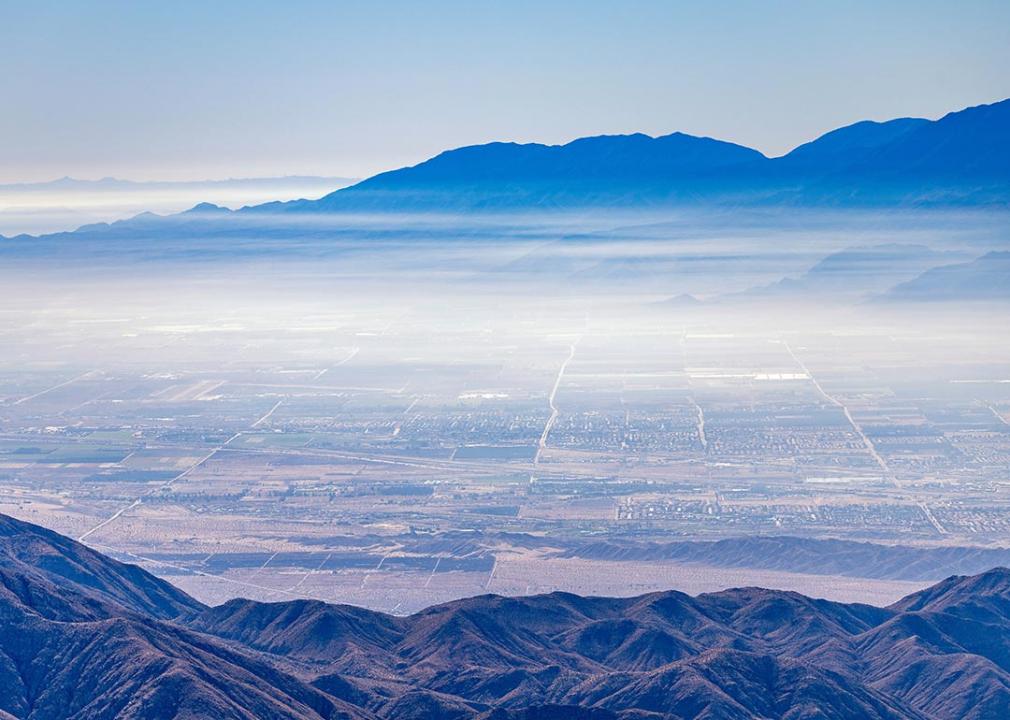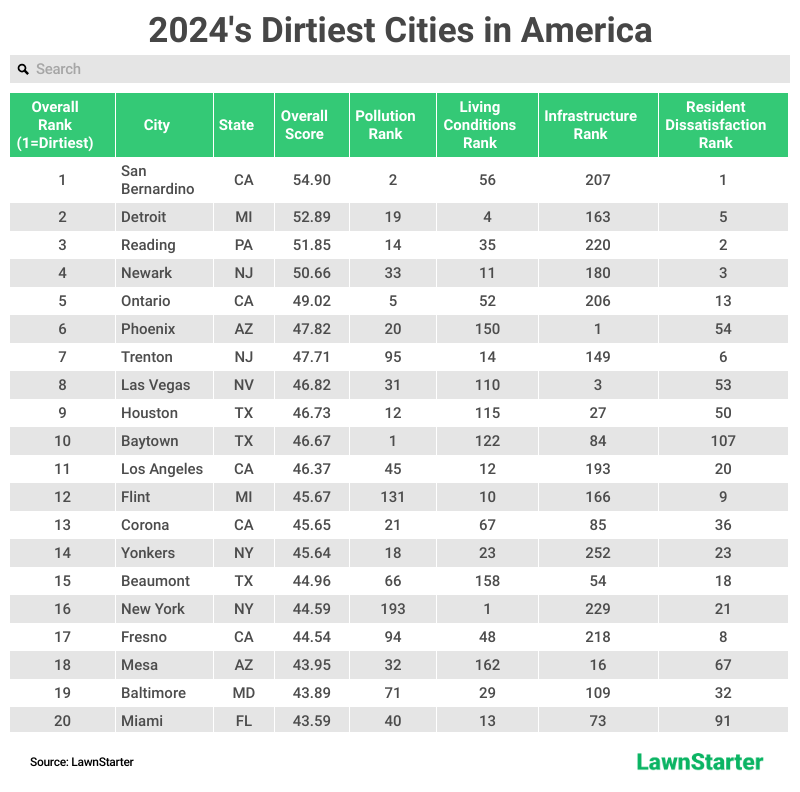2024's dirtiest cities in America

Gerry Matthews // Shutterstock
2024’s dirtiest cities in America
Air pollution seen over the Coachella Valley in San Bernardino County, CA.
City living comes with more entertainment, more job opportunities, and also more pollution, trash, and pests.
Which U.S. cities are the filthiest? To find out, LawnStarter ranked 2024’s Dirtiest Cities in America.
This year, we expanded the scope of our study to encompass over 300 of the biggest U.S. cities based on 4 categories. More specifically, we considered air pollution, water quality, waste management, and resident dissatisfaction levels in each city, among 21 total metrics.
See where your city landed in our ranking below. To learn how we ranked the cities, see our methodology.
City Rankings
See how your city and others fared in our ranking:
![]()

LawnStarter
Top 5 Close Up
Table showing the Top 20 Dirtiest Cities in America.
1st = Dirtiest
No. 1: San Bernardino, California | Overall Score: 54.9
- Median Air Quality Index: 80 | Rank: 1 (tie)
- Share of Overcrowded Homes: 8.8% | Rank: 24
- Number of Junk Yards: 12 | Rank: 37
- Share of Residents Who Find City Dirty and Untidy: 93.8% | Rank: 3
- Share of Residents Dissatisfied with Pollution: 75% | Rank: 1
No. 2: Detroit | Overall Score: 52.89
- Median Air Quality Index: 58 | Rank: 25
- Percentage of Smokers: 29.1% | Rank: 2
- Share of Homes Without Complete Kitchen Facilities: 15.6% | Rank: 1
- Share of Homes Without Complete Plumbing Facilities: 12.7% | Rank: 2
- Share of Residents Who Find City Dirty and Untidy: 79.3% | Rank: 5
No. 3: Reading, Pennsylvania | Overall Score: 51.85
- Greenhouse Gas Emissions per Capita: 18.5 metric tons | Rank: 22
- RSEI Score: 128.48 | Rank: 1
- Percentage of Smokers: 26.5% | Rank: 5
- Share of Residents Who Find City Dirty and Untidy: 100% | Rank: 1
- Share of Residents Dissatisfied with Pollution: 33% | Rank: 58
No. 4: Newark, New Jersey | Overall Score: 50.66
- Median Air Quality Index: 51 | Rank: 69
- Greenhouse Gas Emissions per Capita: 8.4 metric tons | Rank: 44
- Annual Excess Fuel Consumption per Auto Commuter: 23 gallons | Rank: 1
- Share of Residents Who Find City Dirty and Untidy: 88.9% | Rank: 4
- Share of Residents Dissatisfied with Pollution: 50% | Rank: 12
No. 5: Ontario, California | Overall Score: 49.02
- Median Air Quality Index: 80 | Rank: 1 (tie)
- Share of Residents Exposed to Near-Roadway Pollution: 21.6% | Rank: 23
- Quantity of Waste in Landfills per 100,000 Residents: 7.9 million tons | Rank: 41
- Refuse and Recycling Collectors per 100,000 Residents: 26 | Rank: 60
- Share of Residents Dissatisfied with Pollution: 60.7% | Rank: 6
Key Insights
America’s Dirtiest Cities aren’t necessarily full of litterbugs — cities like San Bernardino, California (No. 1), and Detroit (No. 2), primarily deal with polluted air, high levels of greenhouse gas emissions, and records of drinking water violations.
10 California cities in the Inland Empire, like San Bernardino, tie with the worst median air quality. The shipping industry is exploding in this region, with a freight corridor boasting over 4,000 warehouses and nearly 600,000 diesel-fueled trucks driving through the Inland Empire on a daily basis.
The Golden State is a major proponent of electric vehicles and passed a mandate implementing a gradual conversion from diesel to zero-emission big rigs and commercial trucks. California is a frontrunner in implementing green policies, like the Green Lawn Care law, which bans sales of newly manufactured gas-powered lawn care equipment.
Cities in Iowa and Virginia — like Des Moines (No. 295) and Roanoke (No. 297) — score among the least dirty cities in our ranking, near Lynchburg, Virginia, in last place. These cities enjoy less noxious air and near-roadway pollution, low excess fuel consumption, and higher resident satisfaction.
Methodology
First, we determined the factors (metrics) that are most relevant to rank the Dirtiest Cities in America. We then assigned a weight to each factor based on its importance and grouped those factors into 4 categories: Pollution, Living Conditions, Infrastructure, and Resident Dissatisfaction.
For each of the 500 biggest U.S. cities, we then gathered data on each factor from AARP, Centers for Disease Control and Prevention, County Health Rankings & Roadmaps, Numbeo, Other LawnStarter Studies, Refuge Restrooms, Salvage-Parts.com, Texas A&M Transportation Institute, U.S. Bureau of Labor Statistics, U.S. Census Bureau, U.S. Department of Energy, and U.S. Environmental Protection Agency. We eliminated 197 cities lacking sufficient data in a single category, resulting in a final sample size of 303 cities.
Finally, we calculated scores (out of 100 points) for each city to determine its rank in each factor, each category, and overall. A city’s Overall Score is the average of its scores across all factors and categories. The highest Overall Score ranked “Dirtiest” (No. 1) and the lowest “Least Dirty” (No. 303). Note: The “Least Dirty” among individual factors may not be No. 303 due to ties.
Final Thoughts
Today, about 40% of U.S. residents live in regions with unhealthy air quality, breathing in pollutants like particulate matter from wildfire smoke, oil refineries, and vehicles. Exposure to smog can lead to health consequences ranging from asthma to pregnancy loss to lung cancer.
Some states and the federal government are implementing green policies to counteract this dirty trend. This year, the Environmental Protection Agency updated its air quality standards for the first time in 12 years and is taking additional steps to restrict emissions from power plants.
With such varied factors contributing to pollution, there isn’t one solution for cleaning up America’s dirtiest cities. However, there are small steps that can be taken by individuals looking to make their home and neighborhood cleaner and greener.
Explore our guides below.
- Plant a tree and combat local levels of tree cover loss.
- 28% of landfill waste can be composted, so buy a bin and start composting.
- Walk, bike, or take public transportation instead of driving your car.
- Install solar panels or grow a green roof.
- Join a community garden or plant one in your backyard using organic fertilizer.
- Xeriscape your yard and fill it with native plants.
- Go shopping for an electric vehicle.
- Shop local at the farmer’s market and don’t forget to bring your reusable bags.
- Maintain the most sustainable landscaping for your climate.
- Clean up ahead of a storm to prevent debris from polluting your lawn and neighborhood.
Oh, and prepare to celebrate National Upcycling Day next year. Instead of trashing that old boot or bucket, turn it into a flower container. Dirty cities can clean up a bit by repurposing items that would otherwise wind up in a trash heap waiting to be picked up with the garbage.
This story was produced by LawnStarter and reviewed and distributed by Stacker Media.
